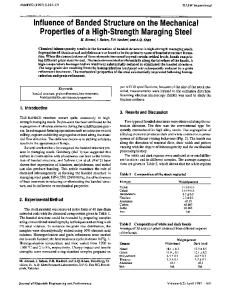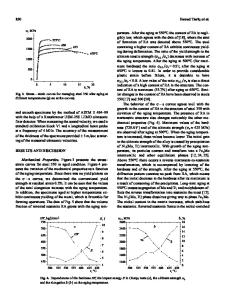Low-temperature elastic properties of a 300-grade maraging steel
- PDF / 569,987 Bytes
- 4 Pages / 612 x 792 pts (letter) Page_size
- 72 Downloads / 587 Views
ELASTIC
p r o p e r t i e s of a 300-grade m a r a g i n g s t e e l (18 Ni, 9 Co, 5 Mo) were studied between r o o m t e m p e r a t u r e and liquid-helium t e m p e r a t u r e . E l a s t i c cons t a n t s w e r e d e t e r m i n e d by m e a s u r i n g the v e l o c i t i e s of both longitudinal and t r a n s v e r s e u l t r a s o n i c waves in a p o l y c r y s t a l l i n e a g g r e g a t e . The following constants a r e r e p o r t e d h e r e : C~ = longitudinal modulus, G = s h e a r modulus, B = bulk modulus, E = Young's modulus, and v = Poisson's ratio. Maraging s t e e l s exhibit some of the b e s t a v a i l a b l e combinations of high strength and high toughness at room t e m p e r a t u r e . 1 Some alloy s t e e l s with high nickel contents a l s o have good toughness at cryogenic t e m p e r a t u r e s . However, the usual heat t r e a t m e n t of m a r aging s t e e l s would probably e m b r i t t l e them at these t e m p e r a t u r e s . Thus, m a r a g i n g s t e e l s would probably be used at low t e m p e r a t u r e s in t h e i r annealed conditions. An annealed 300-grade m a r a g i n g s t e e l was studied (300 indicates a yield s t r e s s of a p p r o x i m a t e l y 300 x 106 psi). This alloy has a b o d y - c e n t e r e d - c u b i c c r y s t a l s t r u c t u r e , and it is f e r r o m a g n e t i c at room t e m p e r a t u r e . Other g r a d e s of annealed m a r a g i n g s t e e l s a r e expected to be s i m i l a r e l a s t i c a l l y because of their s i m i l a r c h e m i c a l compositions. E l a s t i c constants a r e i n t e r e s t i n g for two p r i n c i p a l r e a s o n s . F i r s t , e l a s t i c constants a r e r e l a t e d d i r e c t l y to i n t e r a t o m i c forces; thus, they a r e connected with a v a r i e t y of s o l i d - s t a t e phenomena, including maximum attainable s t r e n g t h s , phase s t a b i l i t i e s , and lattice specific heats. Second, e l a s t i c constants a r e e s s e n tial design p a r a m e t e r s ; the e l a s t i c constants must be known to compute deflections due to applied loads o r s t r e s s e s due to t e m p e r a t u r e changes of c o n s t r a i n e d components. While some data on the t e m p e r a t u r e dependence of the Young's modulus of a 250-grade m a r a g i n g s t e e l a r e available, z data on the other e l a s t i c constants (shear modulus, bulk modulus, P o i s s o n ' s ratio) and on other g r a d e s of m a r a g i n g s t e e l have not been r e p o r t e d . F u r t h e r m o r e , because of the many e l a s t i c - c o n s t a n t a n o m a l i e s exhibited by i r o n - n i c k e l alloys (both those
H. M. LEDBETTER is ResearchMetallurgistand D. T. READ is a Physicistand NRC-NBSPostdoctoral Research Associate, 1975-76, with the CryogenicsDivision,National Bureau of Standards, Boulder, CO 80302. Manuscript submitted December31, 1976. METALLURGICALTRANSACTIONSA
with higher and lower nickel contents than m a r a g i n g s t e e l s ) , and b e c a u s e of th
Data Loading...











